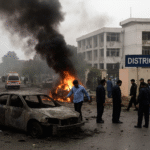Pakistan Army Aviation has officially inducted the Chinese-built Z-10ME attack helicopter, a move that significantly boosts the country’s battlefield capabilities — especially in high-altitude and armored warfare against India. This advanced gunship, tailored for Pakistan’s operational needs, represents a major step forward in the nation’s military modernization.
Z-10ME — Built for Precision and Survival
The Z-10ME is the latest and most advanced variant of China’s Z-10 series. It has been upgraded to meet the challenges of Pakistan’s diverse geography — from deserts to high-altitude mountain regions — while carrying state-of-the-art weapons and protection systems.
Key Features:
-
Advanced Avionics & Targeting: Precision strike capability against moving and stationary targets.
-
Enhanced Armor: Resistant to heavy machine gun fire.
-
Lethal Weaponry: HJ-10 anti-tank guided missiles, TY-90 air-to-air missiles, and a 23mm autocannon.
-
Electronic Warfare (EW): Systems to counter enemy radar and air defense.
These upgrades make the Z-10ME a strong rival to India’s HAL Rudra and LCH Prachand.
Impact on the India–Pakistan Military Balance
Pakistan’s older AH-1F Cobra and Mi-35 Hind helicopters served well but were showing their age compared to India’s newer attack helicopters. The arrival of the Z-10ME changes the equation:
-
Anti-Tank Advantage: HJ-10 missiles can engage Indian T-90 Bhishma and Arjun MBT tanks from over 10 km, staying beyond their effective return fire range.
-
Air Defense Evasion: Low radar profile and EW support help survive against India’s Akash and Spyder surface-to-air missile systems.
-
High-Altitude Capability: Performs efficiently in regions like Siachen, Kargil, and Ladakh, where thin air challenges most helicopters.
Force Multiplier in Joint Operations
The Z-10ME isn’t an isolated asset — it will integrate with Pakistan’s J-10C fighter jets, artillery, and drones for multi-domain warfare.
Benefits of Integration:
-
Coordinated strikes on armored formations.
-
Real-time target sharing via secure datalinks.
-
Swift offensive thrusts or defensive counterattacks.
This synergy strengthens Pakistan’s ability to respond rapidly to any Indian mobilization.
Pakistan–China Defense Cooperation
The Z-10ME acquisition reflects the deep military-technical ties between Islamabad and Beijing. China customized the helicopter for Pakistan’s operational needs, especially for high-altitude missions — a sign of strong strategic trust.
Strategic and Psychological Effects
Military equipment impacts more than combat — it shapes perceptions. The Z-10ME sends a clear signal to India that Pakistan is modernizing quickly, keeping pace with regional rivals, and ensuring deterrence against aggressive doctrines like Cold Start.
FAQs
Q1: What is the Z-10ME’s main role?
It’s an attack helicopter designed for anti-tank, close air support, and battlefield interdiction missions.
Q2: How does it compare to India’s attack helicopters?
With its advanced missiles, EW systems, and high-altitude capability, it can match or exceed India’s HAL Rudra and LCH Prachand in certain roles.
Q3: Who manufactures the Z-10ME?
It is developed by China’s Changhe Aircraft Industries Corporation.
Q4: Why is it important for Pakistan?
It modernizes Pakistan’s helicopter fleet, strengthens deterrence, and improves performance in challenging terrain.
Conclusion
The Z-10ME is more than an aircraft — it’s a strategic statement. With its combination of advanced weapons, survivability, and adaptability, it boosts Pakistan’s deterrence and warfighting capability. In any future standoff, this gunship could play a decisive role in tipping the balance.










